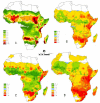Predicting and mapping malaria under climate change scenarios: the potential redistribution of malaria vectors in Africa
- PMID: 20416059
- PMCID: PMC2873524
- DOI: 10.1186/1475-2875-9-111
Predicting and mapping malaria under climate change scenarios: the potential redistribution of malaria vectors in Africa
Abstract
Background: Malaria is rampant in Africa and causes untold mortality and morbidity. Vector-borne diseases are climate sensitive and this has raised considerable concern over the implications of climate change on future disease risk. The problem of malaria vectors (Anopheles mosquitoes) shifting from their traditional locations to invade new zones is an important concern. The vision of this study was to exploit the sets of information previously generated by entomologists, e.g. on geographical range of vectors and malaria distribution, to build models that will enable prediction and mapping the potential redistribution of Anopheles mosquitoes in Africa.
Methods: The development of the modelling tool was carried out through calibration of CLIMEX parameters. The model helped estimate the potential geographical distribution and seasonal abundance of the species in relation to climatic factors. These included temperature, rainfall and relative humidity, which characterized the living environment for Anopheles mosquitoes. The same parameters were used in determining the ecoclimatic index (EI). The EI values were exported to a GIS package for special analysis and proper mapping of the potential future distribution of Anopheles gambiae and Anophles arabiensis within the African continent under three climate change scenarios.
Results: These results have shown that shifts in these species boundaries southward and eastward of Africa may occur rather than jumps into quite different climatic environments. In the absence of adequate control, these predictions are crucial in understanding the possible future geographical range of the vectors and the disease, which could facilitate planning for various adaptation options.
Conclusion: Thus, the outputs from this study will be helpful at various levels of decision making, for example, in setting up of an early warning and sustainable strategies for climate change and climate change adaptation for malaria vectors control programmes in Africa.
Figures



Similar articles
-
Zoom in at African country level: potential climate induced changes in areas of suitability for survival of malaria vectors.Int J Health Geogr. 2014 May 7;13:12. doi: 10.1186/1476-072X-13-12. Int J Health Geogr. 2014. PMID: 24885061 Free PMC article.
-
Distribution of African malaria mosquitoes belonging to the Anopheles gambiae complex.Parasitol Today. 2000 Feb;16(2):74-7. doi: 10.1016/s0169-4758(99)01563-x. Parasitol Today. 2000. PMID: 10652493 Review.
-
Mapping the ranges and relative abundance of the two principal African malaria vectors, Anopheles gambiae sensu stricto and An. arabiensis, using climate data.Proc Biol Sci. 1998 May 22;265(1399):847-54. doi: 10.1098/rspb.1998.0369. Proc Biol Sci. 1998. PMID: 9633110 Free PMC article.
-
Shifting suitability for malaria vectors across Africa with warming climates.BMC Infect Dis. 2009 May 10;9:59. doi: 10.1186/1471-2334-9-59. BMC Infect Dis. 2009. PMID: 19426558 Free PMC article.
-
[Will climate and demography have a major impact on malaria in sub-Saharan Africa in the next 20 years?].Med Trop (Mars). 2009 Apr;69(2):203-7. Med Trop (Mars). 2009. PMID: 19545045 Review. French.
Cited by
-
Spatial panorama of malaria prevalence in Africa under climate change and interventions scenarios.Int J Health Geogr. 2018 Jan 16;17(1):2. doi: 10.1186/s12942-018-0122-3. Int J Health Geogr. 2018. PMID: 29338736 Free PMC article.
-
Influence of global climate change on chemical fate and bioaccumulation: the role of multimedia models.Environ Toxicol Chem. 2013 Jan;32(1):20-31. doi: 10.1002/etc.2044. Environ Toxicol Chem. 2013. PMID: 23136071 Free PMC article.
-
Malaria and large dams in sub-Saharan Africa: future impacts in a changing climate.Malar J. 2016 Sep 5;15(1):448. doi: 10.1186/s12936-016-1498-9. Malar J. 2016. PMID: 27592590 Free PMC article.
-
Achievements and gaps in projection studies on the temperature-attributable health burden: Where should we be headed?Front Epidemiol. 2022 Dec 16;2:1-9. doi: 10.3389/fepid.2022.1063871. Front Epidemiol. 2022. PMID: 37942471 Free PMC article.
-
Entomological Monitoring and Evaluation: Diverse Transmission Settings of ICEMR Projects Will Require Local and Regional Malaria Elimination Strategies.Am J Trop Med Hyg. 2015 Sep;93(3 Suppl):28-41. doi: 10.4269/ajtmh.15-0009. Epub 2015 Aug 10. Am J Trop Med Hyg. 2015. PMID: 26259942 Free PMC article.
References
-
- Levine RS, Peterson AT, Benedict MQ. Geographic and ecologic distributions of the Anopheles Gambiea complex predicted using a genetic algorithm. Am J Trop Med Hyg. 2004;70:105–109. - PubMed
-
- Gillies MT, De Meillon B. The Anophelinae of Africa South of the Sahara. Publication no. 54. Johannesburg, South Africa. South African Institute of Medical Research; 1968.
-
- Gillies MT, Coetzee M. Supplement to the Anophelinae of Africa South of the Sahara. Publication no. 55. Johannesburg, South Africa. South African Institute of Medical Research; 1987.
Publication types
MeSH terms
LinkOut - more resources
Full Text Sources
Medical

